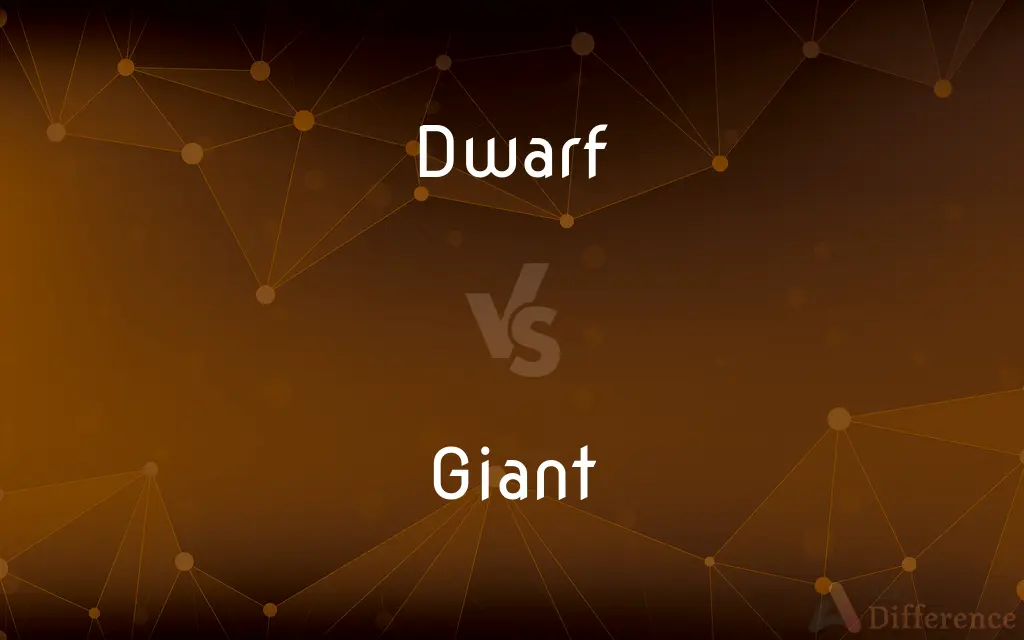Dwarf vs. Giant — What's the Difference?
By Tayyaba Rehman & Maham Liaqat — Updated on March 16, 2024
Dwarf is typically a term for a small being in mythology or fantasy, whereas Giant refers to an exceptionally large person or creature.

Difference Between Dwarf and Giant
Table of Contents
ADVERTISEMENT
Key Differences
Dwarfs, in folklore and fantasy, are often depicted as small, sturdy beings skilled in crafting and mining. They are usually characterized by their strength, wisdom, and connection to the earth. Giants, on the other hand, are portrayed as enormous creatures towering over humans and landscapes alike. Their size is often accompanied by great strength, but in many stories, they lack the cunning and craftiness associated with dwarfs.
Dwarfs are often associated with the underground, living in mountains or deep beneath the earth, where they forge and craft with metals and gems. This connection to the earth often grants them a certain mystique, imbued with ancient knowledge and magical skills. Giants, in contrast, are frequently connected with the vastness of the open sky or vast wilderness areas, embodying raw, untamed power. They are often seen as forces of nature, sometimes benevolent, but often as formidable obstacles for heroes in mythology.
In terms of societal structure, dwarfs are commonly portrayed as living in highly organized communities with a strong emphasis on tradition and craftsmanship. Their societies are often depicted as complex, with a deep sense of history and lore. Giants, whereas, are frequently shown as more solitary beings or living in smaller, less sophisticated groups. Their social structures, when they exist, tend to be simpler, focused more on survival or brute strength rather than intricate social hierarchies or crafts.
Culturally, dwarfs are often celebrated for their skill in craftsmanship, especially in metalwork and gem cutting, leading to their depiction as master smiths and artisans. Their creations, from legendary weapons to intricate jewelry, are often imbued with magic and lore. Giants, on the other hand, are less frequently associated with the creation of objects or crafts. When they are, it is often on a grand scale, such as the construction of massive stone structures or the shaping of landscapes, highlighting their physical prowess over finesse.
In mythology and folklore, the interactions between dwarfs and giants can reflect broader themes of brains over brawn, with the cunning and technologically savvy dwarfs often outsmarting or outmaneuvering the physically stronger but less intellectually inclined giants. This dynamic plays into the classic trope of the underdog overcoming seemingly insurmountable odds through wit and skill.
ADVERTISEMENT
Comparison Chart
Size
Small, often depicted as human-like but shorter.
Large, towering over humans and landscapes.
Habitat
Underground, in mountains or beneath the earth.
Open spaces, such as skies or wilderness.
Society
Highly organized, with a focus on tradition and craftsmanship.
Solitary or in smaller groups, with simpler social structures.
Skills
Skilled in crafting and mining, often magical.
Physical strength, sometimes with elemental powers.
Mythological Role
Often seen as wise and cunning, aiding heroes.
Frequently depicted as obstacles or adversaries to overcome.
Compare with Definitions
Dwarf
A mythical being of small stature known for their craftsmanship and underground dwelling.
In many tales, dwarfs are depicted as living in elaborate underground cities.
Giant
A mythical creature of enormous size, often featured in folklore and fairy tales.
The giant strode across the land, causing the earth to tremble.
Dwarf
A character in fantasy genres, often portrayed with a keen sense for mining and metalwork.
The dwarf in the story was the best blacksmith in the land.
Giant
An exceptionally large person or thing in its category.
The company is considered a giant in the technology sector.
Dwarf
An astronomical term for a star of relatively small size and low brightness.
A white dwarf is the remnant of a star that has exhausted most of its nuclear fuel.
Giant
In astronomy, a star significantly larger and more luminous than the sun.
A red giant is a dying star in the last stages of stellar evolution.
Dwarf
In biology, an organism significantly smaller than the typical size of its species.
The dwarf variety of the plant is suitable for small gardens.
Giant
A large film screen used in outdoor cinemas.
The movie was shown on a giant screen at the park.
Dwarf
A person with a condition resulting in short stature, often due to genetic reasons.
People with dwarfism are represented in various fields, breaking stereotypes.
Giant
An adjective describing something very large or formidable.
They undertook the giant task of cleaning the polluted river.
Dwarf
(in folklore or fantasy literature) a member of a mythical race of short, stocky humanlike creatures who are generally skilled in mining and metalworking.
Giant
In folklore, giants (from Ancient Greek: gigas, cognate giga-) are beings of human-like appearance, but are at times prodigious in size and strength or bear an otherwise notable appearance. The word giant is first attested in 1297 from Robert of Gloucester's chronicle.
Dwarf
A star of relatively small size and low luminosity, including the majority of main sequence stars.
Giant
A person or thing of great size.
Dwarf
Cause to seem small or insignificant in comparison
The buildings surround and dwarf All Saints church
Giant
A person or thing of extraordinary power, significance, or importance
A giant in the field of physics.
Automotive industry giants.
Dwarf
A person with a usually genetic disorder resulting in atypically short stature and often disproportionate limbs.
Giant
Greek Mythology One of a race of humanlike beings of enormous strength and stature who were destroyed in battle with the Olympians.
Dwarf
An atypically small animal or plant.
Giant
A being in folklore or myth similar to one of these beings.
Dwarf
A small creature resembling a human, often having magical powers, appearing in legends and fairy tales.
Giant
A gymnastic maneuver in which the body is swung, fully extended, around a horizontal bar.
Dwarf
A dwarf star.
Giant
Marked by exceptionally great size, magnitude, or power
A giant wave.
A giant impact.
Dwarf
To check the natural growth or development of; stunt
"The oaks were dwarfed from lack of moisture" (John Steinbeck).
Giant
A mythical human of very great size.
Dwarf
To cause to appear small by comparison
"Together these two big men dwarfed the tiny Broadway office" (Saul Bellow).
Giant
(mythology) Specifically:
Dwarf
To become stunted or grow smaller.
Giant
Any of the gigantes, the race of giants in the Greek mythology.
Dwarf
(mythology) Any member of a race of beings from (especially Scandinavian and other Germanic) folklore, usually depicted as having some sort of supernatural powers and being skilled in crafting and metalworking, often as short with long beards, and sometimes as clashing with elves.
Giant
A jotun.
Dwarf
A person of short stature, often one whose limbs are disproportionately small in relation to the body as compared with typical adults, usually as the result of a genetic condition.
Giant
A very tall and large person.
Dwarf
An animal, plant or other thing much smaller than the usual of its sort.
Dwarf tree
Dwarf honeysuckle
Giant
A tall species of a particular animal or plant.
Dwarf
(star) A star of relatively small size.
Giant
(astronomy) A star that is considerably more luminous than a main sequence star of the same temperature (e.g. red giant, blue giant).
Dwarf
Miniature.
The specimen is a very dwarf form of the plant.
It is possible to grow the plants as dwarf as one desires.
Giant
(computing) An Ethernet packet that exceeds the medium's maximum packet size of 1,518 bytes.
Dwarf
(transitive) To render (much) smaller, turn into a dwarf (version).
Giant
A very large organisation.
The retail giant is set to acquire two more struggling high-street chains.
Dwarf
(transitive) To make appear (much) smaller, puny, tiny.
The newly-built skyscraper dwarfs all older buildings in the downtown skyline.
Giant
A person of extraordinary strength or powers, bodily or intellectual.
Dwarf
(transitive) To make appear insignificant.
Bach dwarfs all other composers.
Giant
(gymnastics) A maneuver involving a full rotation around an axis while fully extended.
Dwarf
(intransitive) To become (much) smaller.
Giant
Very large.
Dwarf
To hinder from growing to the natural size; to make or keep small; to stunt.
Giant
A man of extraordinari bulk and stature.
Giants of mighty bone and bold emprise.
Dwarf
An animal or plant which is much below the ordinary size of its species or kind.
Giant
A person of extraordinary strength or powers, bodily or intellectual.
Dwarf
A diminutive human being, small in stature due to a pathological condition which causes a distortion of the proportions of body parts to each other, such as the limbs, torso, and head. A person of unusually small height who has normal body proportions is usually called a midget.
Giant
Any animal, plant, or thing, of extraordinary size or power.
Dwarf
A small, usually misshapen person, typically a man, who may have magical powers; mythical dwarves were often depicted as living underground in caves.
Giant
Like a giant; extraordinary in size, strength, or power; as, giant brothers; a giant son.
Dwarf
To hinder from growing to the natural size; to make or keep small; to stunt.
Even the most common moral ideas and affections . . . would be stunted and dwarfed, if cut off from a spiritual background.
Giant
Any creature of exceptional size
Dwarf
To become small; to diminish in size.
Strange power of the world that, the moment we enter it, our great conceptions dwarf.
Giant
A person of exceptional importance and reputation
Dwarf
A person who is abnormally small
Giant
An unusually large enterprise;
Walton built a retail giant
Dwarf
A legendary creature resembling a tiny old man; lives in the depths of the earth and guards buried treasure
Giant
A very large person; impressive in size or qualities
Dwarf
Make appear small by comparison;
This year's debt dwarves that of last year
Giant
Someone or something that is abnormally large and powerful
Dwarf
Check the growth of;
The lack of sunlight dwarfed these pines
Giant
An imaginary figure of superhuman size and strength; appears in folklore and fair tales
Giant
A very bright star of large diameter and low density (relative to the Sun)
Giant
Of great mass; huge and bulky;
A jumbo jet
Jumbo shrimp
Common Curiosities
Do dwarfs and giants appear in the same mythologies?
Dwarfs and giants appear in various mythologies around the world, sometimes even within the same cultural folklore.
Are there any famous stories involving dwarfs and giants?
Many, including Norse mythology with giants (Jotnar) and dwarfs (Dvergar), and fairy tales like "Jack and the Beanstalk."
What is the origin of dwarf and giant myths?
Dwarf and giant myths originate from various cultures' folklore and mythology, often representing the human fascination with the extremes of size and strength.
Are dwarfs always depicted as good characters in mythology?
Dwarfs are often portrayed as wise and skillful, but like any mythological beings, their moral alignment can vary by story.
Can giants be benevolent in folklore?
Yes, giants can be benevolent or neutral, though they are often depicted as challenges or adversaries in myths.
How are dwarfs and giants typically portrayed in modern media?
In modern media, dwarfs are often seen as skilled warriors or craftsmen, while giants are depicted as formidable opponents or guardians.
Do dwarfs and giants have any symbolic meanings?
Yes, dwarfs often symbolize skill, wisdom, and resilience, while giants can represent overwhelming challenges, nature's forces, or raw power.
Are there modern interpretations of dwarfs and giants?
Modern interpretations can vary, from faithful renditions of traditional myths to entirely new takes in fantasy literature and media.
Are there female dwarfs and giants in mythology?
Yes, both female dwarfs and giants appear in various myths, though they may be less commonly mentioned than their male counterparts.
How do the habitats of dwarfs and giants reflect their characteristics?
Dwarfs' underground habitats reflect their connection to the earth and craftsmanship, while giants' open habitats underscore their vastness and elemental power.
Can dwarfs and giants have magical powers?
Yes, in many stories, dwarfs and giants possess magical abilities, often related to their nature or domain.
In what ways have dwarfs and giants influenced popular culture?
They have influenced popular culture through literature, movies, video games, and more, often serving as key characters or inspirations in fantasy genres.
How do dwarfs and giants interact with other mythological creatures?
Their interactions vary, but they often engage with gods, heroes, and other mythological beings, playing roles that range from allies to adversaries.
How do children's stories portray dwarfs and giants?
In children's stories, dwarfs often appear as friendly and helpful, while giants might be portrayed as less scary and more comical than in traditional myths.
Have dwarfs and giants been represented in visual arts?
Yes, both have been depicted in various forms of visual arts, from ancient sculptures and paintings to modern digital art.
Share Your Discovery

Previous Comparison
Brandy vs. Rum
Next Comparison
Pole vs. RodAuthor Spotlight
Written by
Tayyaba RehmanTayyaba Rehman is a distinguished writer, currently serving as a primary contributor to askdifference.com. As a researcher in semantics and etymology, Tayyaba's passion for the complexity of languages and their distinctions has found a perfect home on the platform. Tayyaba delves into the intricacies of language, distinguishing between commonly confused words and phrases, thereby providing clarity for readers worldwide.
Co-written by
Maham Liaqat















































